Turquoise Checkerboard Discus – Symphysodon aequifasciatus “Turquoise Checkerboard” size 5 to, Stunning Tropical Fish, Ideal Companions for Beginner Aquarists Seeking Colorful Additions
£64.99 Original price was: £64.99.£55.00Current price is: £55.00.
Welcome these beautiful Turquoise Checkerboard Discus, a stunning addition to your freshwater aquarium. Their vibrant colors and graceful movements make them ideal community fish. Perfect for aquarists asking about colorful fish, these peaceful companions will enhance your aquatic environment.
Species Introduction
The Turquoise Checkerboard Discus, scientifically known as Symphysodon aequifasciatus, is a mesmerizing species belonging to the Cichlidae family. Originating from the Amazon River basin, these stunning tropical fish thrive in the warm, slow-moving waters of South America. Their vibrant turquoise coloration adorned with intricate checkerboard patterns makes them a favorite among aquarists. These fish are not only visually captivating but also exhibit a gentle demeanor, making them ideal companions for community tanks. Understanding their natural habitat is crucial for creating an environment that mimics their native conditions, ensuring their health and well-being.
Care Requirements Dashboard
Essential Care Guide for Your Turquoise Checkerboard Discus
| Optimal Living Conditions | |
|---|---|
| Water Temperature | 24-27°C (75-81°F) |
| pH Level | 6.5-7.5 |
| Water Hardness | 4-12 dKH |
| Minimum Tank Size | 80L (20 gal) |
| Salinity | Freshwater |
| Care Level | Beginner Friendly |
✓ Care Level: Easy
Natural Behavior & Temperament
The Turquoise Checkerboard Discus is known for its graceful swimming patterns and peaceful temperament. These fish are social creatures that thrive in groups, often displaying a fascinating hierarchy within their schools. They are generally calm and can coexist harmoniously with other peaceful fish species, making them excellent candidates for community tanks. Observing their interactions can be a rewarding experience, as they often engage in playful behaviors and display their vibrant colors. However, it is essential to provide them with ample space and hiding spots to reduce stress and promote a healthy social structure.
Tank Setup Guide
Creating an ideal environment for your Turquoise Checkerboard Discus is vital for their overall health and happiness. Start with a spacious tank of at least 50 gallons to accommodate their swimming needs. The substrate should be soft, such as sand or fine gravel, to prevent injury to their delicate bodies. Incorporate plenty of live plants, driftwood, and rocks to mimic their natural habitat and provide hiding spots. These elements not only enhance the aesthetic appeal of the aquarium but also contribute to the fish’s sense of security. Ensure that the tank has a gentle filtration system to maintain water quality while avoiding strong currents that can stress these gentle swimmers.
Water Quality Management
⚠ Water Parameter Notice
Maintaining optimal water quality is crucial for the health of your Turquoise Checkerboard Discus. Regular water changes of 25-30% weekly will help keep the water clean and free of harmful toxins. Monitor the pH level, ensuring it stays between 6.0 and 7.5, and maintain a temperature range of 82°F to 86°F (28°C to 30°C). Use a reliable water testing kit to check for ammonia, nitrites, and nitrates regularly. Keeping the hardness soft to slightly hard (2-10 dGH) is also essential for their well-being. Proper filtration and aeration will contribute to a stable environment, allowing your fish friends to thrive.
Feeding & Nutrition
Feeding your Turquoise Checkerboard Discus a balanced diet is vital for their growth and vibrant coloration. These fish are omnivorous and thrive on a varied diet that includes high-quality pellets, frozen or live foods such as brine shrimp, bloodworms, and daphnia. A feeding schedule of 2-3 times per day is recommended, with small portions to prevent overfeeding. It is important to remove any uneaten food promptly to maintain water quality. Supplementing their diet with spirulina flakes or vegetable matter can enhance their health and coloration. Observing their feeding behavior can also provide insights into their overall well-being and happiness.
Compatibility Guide
| Fish Species | Compatibility |
|---|---|
| Neon Tetra | Compatible |
| Corydoras Catfish | Compatible |
| Guppy | Compatible |
| Angelfish | Moderately Compatible |
| Goldfish | Not Compatible |
Health & Wellness
Monitoring the health of your Turquoise Checkerboard Discus is essential for their longevity and quality of life. Common health issues include ich, fin rot, and stress-related ailments. Signs of illness may include loss of appetite, lethargy, or abnormal swimming behavior. Regular water quality checks and maintaining a stable environment can help prevent many health problems. Quarantining new fish before introducing them to the main tank is also advisable to avoid the spread of diseases. If any health issues arise, prompt treatment is necessary to ensure the well-being of your aquatic companions.
Breeding Information
Breeding Turquoise Checkerboard Discus can be a rewarding experience for dedicated aquarists. These fish are egg layers and typically require a breeding pair to successfully reproduce. Providing a separate breeding tank with optimal conditions—such as slightly warmer water and a flat surface for egg laying—can encourage spawning. After fertilization, the parents will guard the eggs, which usually hatch within 48 hours. Once the fry are free-swimming, they require specialized care, including finely crushed food and frequent water changes to maintain quality. Patience and attention to detail are key to successfully raising discus fry.
Acclimation Process
Introducing your Turquoise Checkerboard Discus to a new tank requires careful acclimation to minimize stress. Begin by floating the sealed bag in the aquarium for about 15-20 minutes to equalize the temperature. After this, gradually mix small amounts of tank water into the bag over the next hour. This slow introduction helps the fish adjust to the new water parameters. Once acclimated, gently place the fish into the tank using a net to avoid adding any transport water. Observing their behavior closely during the first few days in their new home is crucial to ensure they are settling in well.
Long-term Care
Caring for your Turquoise Checkerboard Discus over the long term involves consistent attention to their needs. These fish can live for 10-15 years with proper care, making them a long-term commitment. Regular maintenance, including water changes, tank cleaning, and monitoring of water parameters, is essential for their health. Additionally, maintaining a balanced diet and providing a stress-free environment will contribute to their happiness and longevity. As they grow, you may need to upgrade their tank size or adjust tank mates to accommodate their needs.
Natural Habitat Recreation
Recreating the natural habitat of the Turquoise Checkerboard Discus in your aquarium is vital for their well-being. Mimicking the Amazon River’s slow-moving waters involves incorporating soft substrates, live plants, and driftwood. Use floating plants to create shaded areas and reduce light intensity, as these fish prefer dimly lit environments. The addition of natural decor not only enhances the visual appeal of the aquarium but also provides hiding spots and territories for the fish. Creating a biotope that reflects their native habitat will help them feel secure and thrive in your care.
Seasonal Care Adjustments
As seasons change, so do the needs of your Turquoise Checkerboard Discus. During warmer months, ensure that the water temperature remains stable, as fluctuations can stress the fish. Consider using a heater with a thermostat to maintain optimal conditions. In cooler months, monitor the tank’s temperature closely, as these fish thrive in warmer waters. Adjust your feeding schedule and diet based on their activity levels, as they may require more food during breeding seasons. Regularly check water parameters and make necessary adjustments to ensure their comfort throughout the year.
Expert Tips
For those looking to provide the best care for their Turquoise Checkerboard Discus, consider the following expert tips. First, invest in a high-quality filtration system to maintain excellent water quality, as these fish are sensitive to poor conditions. Regularly test the water parameters and make adjustments as needed. Secondly, provide a varied diet to enhance their coloration and health; consider incorporating live foods into their feeding routine. Lastly, observe their social interactions closely to ensure that all tank mates are compatible and that no bullying occurs. Creating a harmonious environment will lead to a thriving community tank.
Troubleshooting
Despite your best efforts, you may encounter challenges while caring for your Turquoise Checkerboard Discus. Common issues include stress from aggressive tank mates or poor water quality. If you notice signs of stress, such as hiding or erratic swimming, consider isolating the affected fish or adjusting tank mates. If health issues arise, such as white spots or fin damage, consult a veterinarian or aquatic specialist for appropriate treatment options. Maintaining a close eye on your fish and their environment will help you address any problems promptly, ensuring a healthy and happy aquarium.
Scientific Background
The Turquoise Checkerboard Discus is a member of the Cichlidae family and falls under the genus Symphysodon. This genus is known for its unique body shape and vibrant colors, making discus fish some of the most sought-after species in the aquarium trade. Their scientific classification highlights their evolutionary adaptations to life in the Amazon River basin, where they have developed specific behaviors and physical traits suited to their environment. Understanding their scientific background can deepen your appreciation for these beautiful creatures and enhance your care practices.
Advanced Care Techniques
For dedicated aquarists looking to elevate their care for Turquoise Checkerboard Discus, advanced techniques can be employed. Consider implementing a breeding program to produce healthy fry, which requires specialized tanks and diets. Additionally, experimenting with different plant species can enhance the aesthetic and biological diversity of your aquarium. Advanced water conditioning techniques, such as using reverse osmosis systems, can help achieve optimal water parameters tailored to discus needs. Engaging in continuous learning and networking with fellow aquarists can provide valuable insights and foster a deeper connection with these aquatic companions.
Frequently Asked Questions
Q: What tank size is required for the Turquoise Checkerboard Discus?
The Turquoise Checkerboard Discus requires a minimum tank size of 200 litres (around 52 gallons) for a small group. This size allows ample swimming space and helps maintain stable water conditions, which are crucial for their health. Discus are sensitive to water quality and prefer a well-filtered environment. If you plan to keep a larger group, consider a tank of 300 litres (79 gallons) or more. Additionally, ensure the tank is equipped with a suitable filtration system to manage the bio-load effectively. Remember, the larger the tank, the easier it is to maintain ideal water parameters.
✓ Expert Tip
Consider using a soft substrate like sand or fine gravel to mimic their natural habitat and reduce stress.
Q: What water parameters do Turquoise Checkerboard Discus require?
Turquoise Checkerboard Discus thrive in soft, acidic water with a pH between 6.0 and 7.0. The temperature should be maintained between 26°C to 30°C (79°F to 86°F). Regular water changes of 25-50% weekly are essential to keep the water clean and parameters stable. Additionally, they prefer low hardness, ideally under 10 dGH. Monitoring these parameters with a reliable test kit is crucial, as fluctuations can lead to stress or illness. Keeping the tank well-aerated and ensuring it is cycled before introducing the fish will provide a healthy environment.
✓ Expert Tip
Consider using a reverse osmosis (RO) system to achieve the ideal water conditions if your tap water is hard or alkaline.
Q: How often should I feed my Turquoise Checkerboard Discus?
Feed your Turquoise Checkerboard Discus two to three times daily, providing only what they can consume within a few minutes. A varied diet is essential for their health; include high-quality pellets, frozen or live foods such as bloodworms, and brine shrimp. Additionally, incorporate vegetable-based foods like spirulina to ensure a balanced nutrition profile. Overfeeding can lead to water quality issues, so it’s crucial to monitor their intake and adjust accordingly. Regular feeding helps them grow and maintain vibrant colours, contributing to their overall wellbeing.
✓ Expert Tip
Consider using a feeding schedule to maintain consistency and monitor their health effectively.
Q: What are the best tank mates for Turquoise Checkerboard Discus?
When selecting tank mates for Turquoise Checkerboard Discus, opt for peaceful species that thrive in similar water conditions. Suitable companions include neon tetras, cardinals, and other small, non-aggressive fish. Avoid keeping them with fin-nippers or overly aggressive species, as this can lead to stress and injury. Additionally, ensure that all fish are of a similar size to prevent bullying. It’s advisable to introduce new tank mates gradually and monitor their interactions closely to ensure a harmonious community.
✓ Expert Tip
Consider keeping a small group of Discus together, as they are social fish and thrive in a group setting.
Q: How do I properly acclimatise my Turquoise Checkerboard Discus to my aquarium?
Acclimatising your Turquoise Checkerboard Discus is crucial to prevent shock. Begin by floating the sealed bag in your aquarium for about 15-20 minutes to equalise the temperature. After this, gradually introduce small amounts of your aquarium water into the bag every 10 minutes for about an hour. This process helps the fish adjust to the water chemistry. Finally, gently release the fish into the aquarium using a net, discarding the bag water to avoid introducing contaminants. Monitoring them for signs of stress or illness post-acclimatisation is essential.
✓ Expert Tip
Acclimatisation is best done in low light conditions to help reduce stress on the fish.
Q: What are the signs of healthy Turquoise Checkerboard Discus?
Healthy Turquoise Checkerboard Discus exhibit vibrant colours, clear eyes, and active swimming behaviour. They should have a plump body shape and show interest in food. Additionally, their fins should be fully extended without any signs of fraying or tearing. Regular monitoring of their behaviour is essential; lethargy, hiding, or a lack of appetite can indicate stress or illness. Regular water quality checks and proper tank maintenance will help prevent health issues, allowing your fish friends to thrive.
✓ Expert Tip
Keep a health journal to track any changes in behaviour or appearance, aiding in early detection of potential issues.
Q: How do I successfully breed Turquoise Checkerboard Discus?
Breeding Turquoise Checkerboard Discus requires a well-maintained environment, including stable water parameters and ample space. To encourage breeding, provide flat surfaces such as slate or broad leaves for spawning. The female will lay eggs, and the male will fertilise them. It’s essential to maintain excellent water quality and increase the temperature slightly to stimulate breeding behaviour. After hatching, the fry will feed on their parents’ mucous for the first few days. Providing finely crushed food or specialised fry food is crucial as they grow.
✓ Expert Tip
Consider setting up a separate breeding tank to minimise stress on the parents and protect the fry.
Q: What temperature should I maintain for Turquoise Checkerboard Discus?
The ideal temperature range for Turquoise Checkerboard Discus is between 26°C to 30°C (79°F to 86°F). Maintaining a stable temperature is crucial, as fluctuations can lead to stress and health issues. Use a reliable aquarium heater with a thermometer to monitor and maintain the right conditions. It’s advisable to check the temperature daily, especially during seasonal changes, to ensure the fish remain comfortable and healthy. If you notice significant temperature changes, consider using a heater guard to prevent overheating.
✓ Expert Tip
Invest in an aquarium controller to automate temperature regulation for optimal comfort.
Q: How long do Turquoise Checkerboard Discus typically live in captivity?
With proper care, Turquoise Checkerboard Discus can live for 10 to 15 years in captivity. Their lifespan is heavily influenced by water quality, diet, and overall tank conditions. Regular maintenance, including water changes and monitoring of parameters, is essential for their longevity. A balanced diet rich in nutrients will also contribute to their health and lifespan. By providing a stable and suitable environment, aquarium keepers can ensure their fish friends thrive for many years.
✓ Expert Tip
Consider keeping a regular schedule for health checks and water parameter testing to optimise their care.
Q: What type of substrate is most suitable for Turquoise Checkerboard Discus?
For Turquoise Checkerboard Discus, a soft substrate like fine gravel or sand is ideal. This type of substrate mimics their natural habitat and reduces stress, as sharp edges can injure their delicate bodies. Additionally, a softer substrate allows for easier cleaning and maintenance. When setting up the aquarium, ensure the substrate is at least 5 cm deep to facilitate beneficial bacteria growth, which aids in maintaining water quality. Regularly vacuuming the substrate during water changes helps keep the environment clean.
✓ Expert Tip
Consider adding live plants to your aquarium, which not only enhance aesthetics but also contribute to water quality.
Q: What behavioural patterns should I expect from Turquoise Checkerboard Discus?
Turquoise Checkerboard Discus are generally peaceful and social fish, often seen swimming gracefully in the mid to upper levels of the tank. They exhibit strong school behaviour, so it is advisable to keep them in groups of at least five to reduce stress. They may establish a hierarchy within the group, displaying subtle dominance behaviours. During feeding times, they become quite active and display their vibrant colours. However, they can be shy initially, often seeking shelter amongst plants or decorations until they acclimatise to their new environment.
✓ Expert Tip
Provide plenty of hiding spots with plants and decorations to help them feel secure in their environment.
Q: How can I prevent common diseases in Turquoise Checkerboard Discus?
Preventing diseases in Turquoise Checkerboard Discus begins with maintaining optimal water quality and parameters. Regular water changes, proper filtration, and avoiding overfeeding are key components. Quarantining new fish before introducing them to the main tank can prevent the spread of diseases. Observing your fish for any signs of illness, such as changes in behaviour or appearance, allows for early intervention. Additionally, consider incorporating a high-quality diet rich in vitamins to boost their immune system. Keeping the tank clean and well-maintained greatly reduces the risk of disease.
✓ Expert Tip
Consider using herbal treatments as a preventive measure against common fish ailments.
Q: What lighting conditions do Turquoise Checkerboard Discus prefer?
Turquoise Checkerboard Discus prefer moderate lighting in their aquarium. Bright lighting can stress them, so it is advisable to use soft, diffused lighting to create a more natural environment. LED lights with a dimming feature can help simulate day and night cycles, promoting a healthy lifestyle. Additionally, incorporating live plants into the tank can help diffuse the light and provide shaded areas for the fish to retreat. Regularly adjusting the lighting duration to about 10-12 hours a day will help maintain a balanced ecosystem.
✓ Expert Tip
Consider using a timer for the lights to ensure consistent lighting periods, reducing stress for your fish.
Q: How do I recognise stress in Turquoise Checkerboard Discus?
Recognising stress in Turquoise Checkerboard Discus is crucial for their health. Signs of stress include hiding for prolonged periods, rapid gill movement, and lack of interest in food. Additionally, if they display erratic swimming patterns or show signs of aggression towards tank mates, it may indicate stress. Ensure to monitor water quality regularly, as poor conditions can lead to stress. Providing a calm environment with plenty of hiding spots and stable parameters will help minimise stress levels for your fish friends.
✓ Expert Tip
Address any factors causing stress immediately, whether it’s water quality or tank mate compatibility issues.
Q: What natural habitat conditions should I replicate for Turquoise Checkerboard Discus?
In their natural habitat, Turquoise Checkerboard Discus are found in slow-moving waters with plenty of vegetation. To replicate these conditions, provide a well-planted aquarium with hiding spots and driftwood. The water should be soft and slightly acidic, mimicking the Amazon River basin where they originate. Maintaining a stable temperature and ensuring good water flow will also help recreate their natural environment. Regular water changes will keep the environment clean and healthy, promoting the overall wellbeing of your fish friends.
✓ Expert Tip
Consider adding natural materials like peat to further soften the water and enhance the habitat.



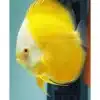

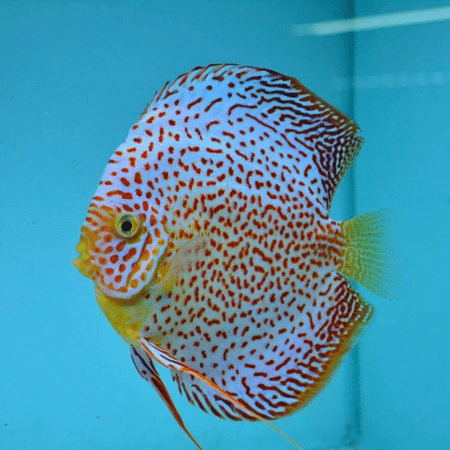
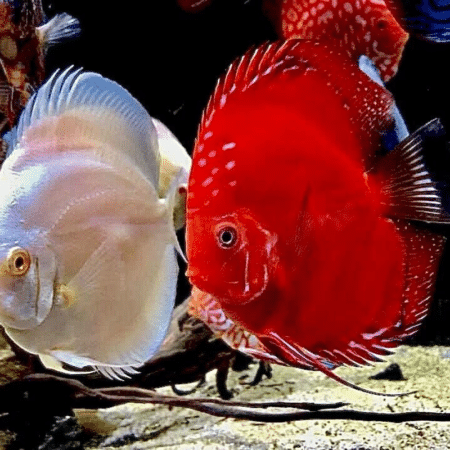
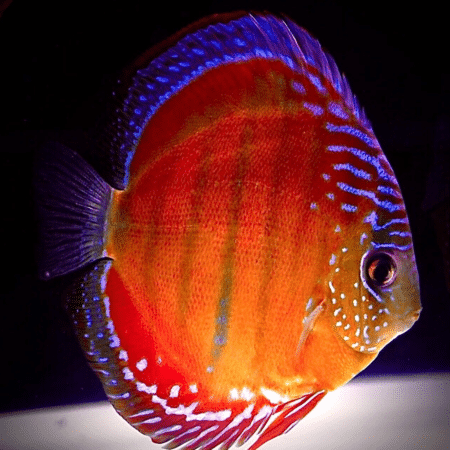
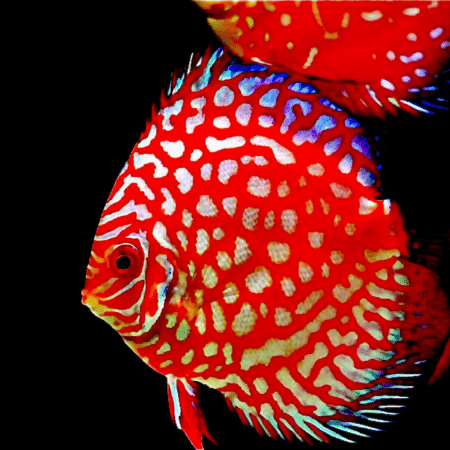

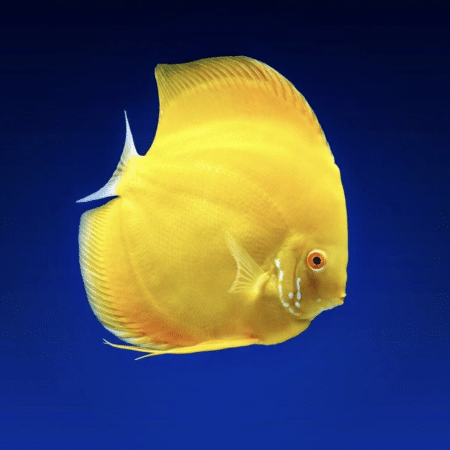
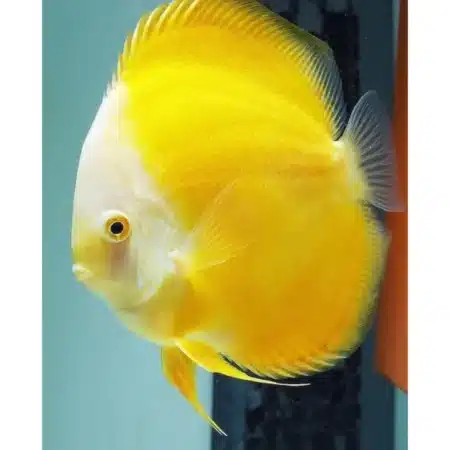
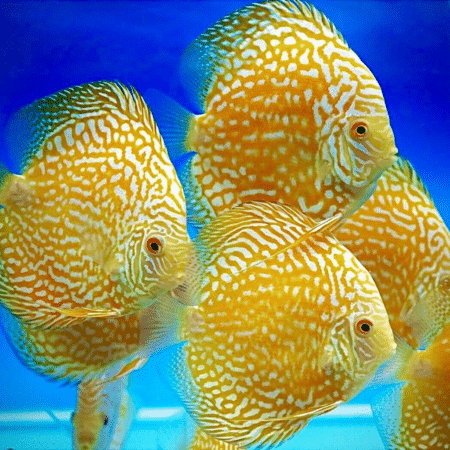
Emily Roberts (verified owner) –
I recently purchased the Turquoise Checkerboard Discus, and I couldn’t be happier! These little beauties, ranging from 5 to 7 cm, have added such vibrant colors to my aquarium. After about two weeks of care, I’ve seen them adapt wonderfully, swimming gracefully and interacting with their environment. Their health seems excellent, which is a huge relief as a caring fish parent.
Compared to other discus fish I’ve kept, the turquoise pattern makes them stand out so much more. They truly captivate anyone who sees them! Each fish has its unique personality, and I love how they come to the front of the tank when I approach. I did notice that they can be a bit shy at first, so I recommend giving them plenty of hiding spots to feel secure.
Shipping was quick, and they arrived in perfect condition, thanks to the careful packaging. I would recommend these discus fish to anyone looking to enhance their aquarium, whether you’re a beginner or a seasoned aquarist. Overall, I’m thrilled with my purchase and would definitely buy again!
Emily Carter (verified owner) –
I recently purchased the Turquoise Checkerboard Discus, and I couldn’t be more thrilled! These discus fish are absolutely stunning, with their vibrant turquoise colors and intricate patterns. After about two weeks in my 75-gallon tank, they’ve settled in beautifully. I’ve noticed their personalities coming to life as they swim gracefully around the tank, and they have become quite the focal point for my family and friends.
I appreciate that these fish are beginner-friendly, making them perfect companions for anyone looking to start their aquarium journey. They’ve been very active and healthy, and I’ve seen them thrive with a little water conditioning and a varied diet of high-quality pellets and frozen foods.
Compared to my previous experiences with other types of tropical fish, the discus offer a unique charm and interaction that I truly adore. The only minor concern I have is that these fish can be a bit sensitive to water quality, so regular testing and maintenance are key.
Overall, I highly recommend the Turquoise Checkerboard Discus for any aquarist looking to add a splash of color and personality to their tank. I’ll definitely be buying more in the future!